
A cocktail is a mixed drink, usually alcoholic. Most commonly, a cocktail is a combination of one or more spirits mixed with other ingredients, such as juices, flavored syrups, tonic water, shrubs, and bitters. Cocktails vary widely across regions of the world, and many websites publish both original recipes and their own interpretations of older and more famous cocktails.

A Manhattan is a cocktail made with whiskey, sweet vermouth, and bitters. While rye is the traditional whiskey of choice, other commonly used whiskies include Canadian whisky, bourbon, blended whiskey, and Tennessee whiskey. The cocktail is usually stirred with ice then strained into a chilled cocktail glass and garnished traditionally with a maraschino cherry. A Manhattan may also be served on the rocks in a lowball glass.
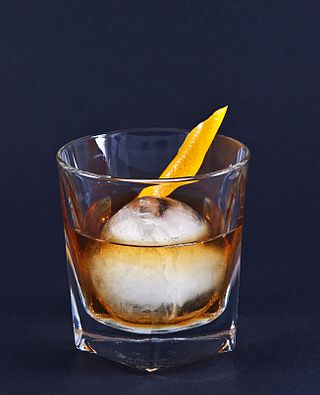
The old fashioned is a cocktail made by muddling sugar with bitters and water, adding whiskey or sometimes brandy, and garnishing with an orange slice or zest and a cocktail cherry. It is traditionally served with ice in an old fashioned glass.

The Rob Roy is a cocktail consisting primarily of whisky and vermouth, created in 1894 by a bartender at the Waldorf Astoria in Manhattan, New York City. The drink was named in honor of the premiere of Rob Roy, an operetta by composer Reginald De Koven and lyricist Harry B. Smith loosely based upon Scottish folk hero Rob Roy MacGregor.

Vermouth is an aromatized fortified wine, flavoured with various botanicals and sometimes colored. The modern versions of the beverage were first produced in the mid to late 18th century in Turin, Italy. While vermouth was traditionally used for medicinal purposes, it was later served as an apéritif, with fashionable cafés in Turin serving it to guests around the clock. In the late 19th century, it became popular with bartenders as a key ingredient for cocktails, such as the martini, the Manhattan, the Rob Roy, and the Negroni. In addition to being consumed as an aperitif or cocktail ingredient, vermouth is sometimes used as an alternative to white wine in cooking.

A bitters is traditionally an alcoholic preparation flavored with botanical matter for a bitter or bittersweet flavor. Originally, numerous longstanding brands of bitters were developed as patent medicines, but now are sold as digestifs, sometimes with herbal properties, and as cocktail flavorings.

The martini is a cocktail made with gin and vermouth, and garnished with an olive and/or a lemon twist. Over the years, the martini has become one of the best-known mixed alcoholic beverages. A common variation, the vodka martini, uses vodka instead of gin for the cocktail's base spirit.
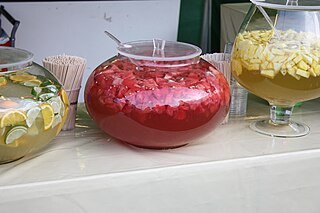
The term punch refers to a wide assortment of drinks, both non-alcoholic and alcoholic, generally containing fruits or fruit juice. The drink was introduced from the Indian subcontinent to England by employees of the East India Company in the late 17th century. Punch is usually served at parties in large, wide bowls, known as punch bowls.

The negroni is a cocktail, made of equal parts gin, vermouth rosso, and Campari, generally served on the rocks, and commonly garnished with an orange slice or orange peel. It is considered an apéritif.
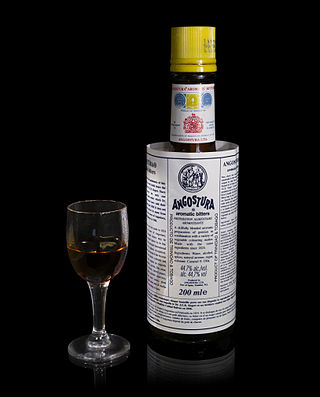
Angostura bitters is a concentrated bitters based on gentian, herbs, and spices, produced by House of Angostura in Trinidad and Tobago. It is typically used for flavouring beverages, or less often, food. The bitters were first produced in the town of Angostura, hence the name, but do not contain angostura bark. The bottle is recognisable by its distinctive oversized label and yellow cap. Angostura is Spanish for "narrowing", the town of Angostura having been at the first narrowing of the Orinoco River.
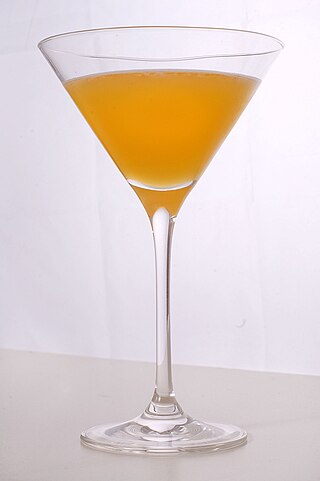
The Bronx is a cocktail. It is essentially a Perfect Martini with orange juice added. It was ranked number three in "The World's 10 Most Famous Cocktails in 1934" behind the Martini (#1) and the Manhattan (#2). In the 1934 movie "The Thin Man", the lead actor compared the methods for shaking the Manhattan, the Bronx and the Martini.

The Fine Art of Mixing Drinks is a book about cocktails by David A. Embury, first published in 1948. The book is noteworthy for its witty, highly opinionated and conversational tone, as well as its categorization of cocktails into two main types: aromatic and sour; its categorization of ingredients into three categories: the base, modifying agents, and special flavorings and coloring agents; and its 1:2:8 ratio for sour type cocktails.
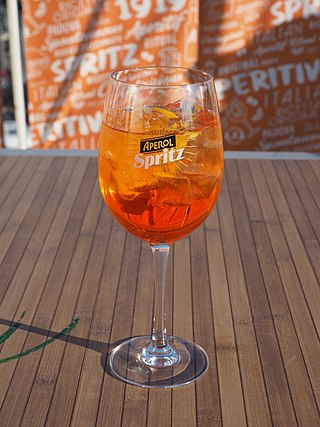
A spritz is an Italian wine-based cocktail, commonly served as an apéritif across Italy. It consists of Prosecco, digestive bitters and soda water. The original spritz veneziano uses Select as bitters and was created in Venice in 1920. Popular variants are spritz al Campari, which uses Campari, and Aperol spritz, which uses Aperol as bitters
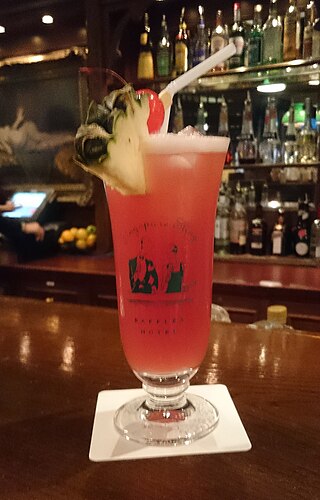
A sling is a drink historically made with sugar, hot or cold water, nutmeg, and a spirit such as gin, whiskey, rum, or brandy. In its modern form, it is made with gin and, varyingly, of ingredients such as sweet vermouth, lemon juice, simple syrup, Angostura bitters, and soda water. Some sources suggest the word sling comes from the German schlingen, meaning "to swallow fast". The Oxford English Dictionary says that the origin is uncertain.
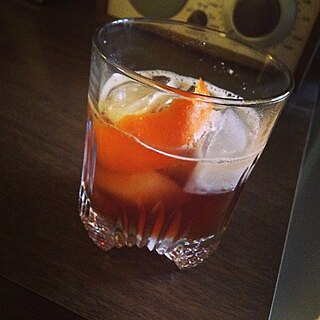
The Toronto is a dry, rich, and mildly bitter cocktail consisting of rye whisky, Fernet-Branca, angostura bitters, and either sugar or simple syrup. An article in Gizmodo by Brent Rose describes it as the "most popular legit cocktail that uses fernet". It is named after the Canadian city of Toronto.
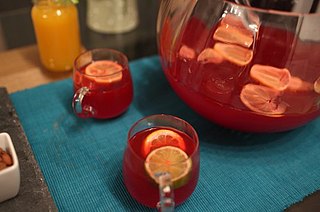
Chapman is a non-alcoholic drink, usually red in colour. Often referred to as a non-alcoholic punch, it is traditionally made with a mix of Fanta, Sprite, Cucumber, Lemon, Grenadine and Angostura bitters and is traditionally served in a large mug with ice and a few slices of cucumber. It is often described as Nigeria's favourite drink and though predominantly served without alcohol, it can also be served with a hint of vodka or rum.

The Martinez is a classic cocktail that is widely regarded as the direct precursor to the Martini. It serves as the basis for many modern cocktails, and several different versions of the original exist. These are generally distinguished by the accompaniment of either Maraschino or Curacao, as well as differences in gin or bitters.

A whiskey cocktail is a cocktail that includes whiskey. Although whiskey is often served neat or on the rocks, it is used in many classic cocktails such as the Old Fashioned, Manhattan, and Julep. Some specifically call for Scotch whisky or bourbon whiskey.

















